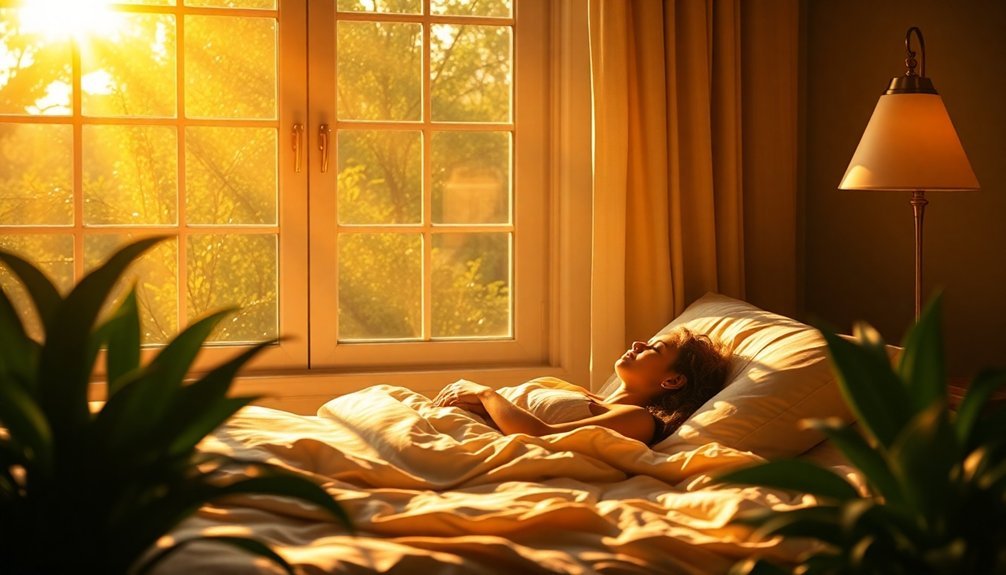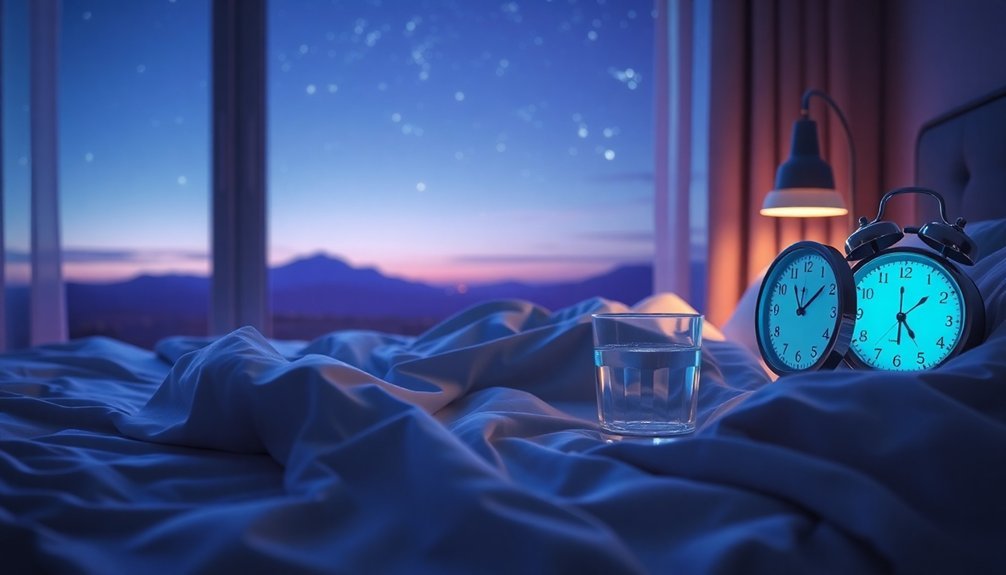Wavelength therapy can effectively reset your sleep clock in several ways. First, exposing yourself to bright morning light syncs your circadian rhythm, improving sleep timing. Second, using evening red light doesn't disrupt melatonin production, helping you prepare for sleep naturally. Third, specific wavelengths can enhance melatonin levels, particularly in the morning. Fourth, maintaining consistency in your light exposure reinforces your internal clock. Finally, various devices, like light therapy lamps and blue light blockers, enhance sleep quality. If you're curious about how to implement these strategies, you'll find plenty of practical tips ahead.
Morning Light Exposure Benefits

When you start your day with bright morning light, you're not just waking up; you're actively resetting your body's internal clock. This exposure synchronizes your circadian rhythm with the natural day-night cycle, influencing your hormone production, especially melatonin.
By getting morning light, you advance your melatonin rhythm, helping you regulate sleep timing and improve overall sleep quality. You'll notice you can fall asleep more quickly at night and wake up feeling refreshed.
Morning light enhances sleep efficiency, reduces sleep fragmentation, and leads to an earlier sleep onset. Compared to regular indoor lighting, morning sunlight makes you feel less sleepy and more alert throughout the day. Additionally, morning sunlight provides benefits for appetite-related hormones, enhancing metabolic health and supporting weight management.
Additionally, basking in morning light provides your body with essential vitamin D, which is crucial for good mental health and a robust immune system. It also helps regulate stress levels, giving you a calming start to your day.
The sunlight stimulates melanin production, enhancing your skin's protection against future UV exposure. With all these benefits, embracing morning light can profoundly improve your mental and physical well-being, creating a ripple effect that keeps you energized and focused throughout the day.
Evening Red Light Use
Using red light in the evening can greatly improve your sleep experience. This light exposure helps regulate your body's internal clock, enhancing your circadian rhythms for healthier sleep-wake cycles. Unlike blue light, red light won't disrupt these rhythms, making it a safe option for nighttime use. Plus, it doesn't suppress melatonin production, allowing your body to naturally prepare for sleep. Additionally, studies show that red light therapy can significantly reduce symptoms of sleep disorders like insomnia and sleep apnea.
Incorporating red light therapy into your evening routine can also reduce stress and anxiety levels. The increase in endorphins helps you relax, setting the perfect mood for sleep. Here's a quick overview of the benefits of evening red light use:
| Benefit | Explanation | Impact on Sleep Quality |
|---|---|---|
| Circadian Rhythm Regulation | Enhances synchronization of internal clock | Promotes balanced sleep-wake cycle |
| Stress & Anxiety Reduction | Increases endorphin production | Creates a calming environment |
| Melatonin Promotion | Stimulates natural melatonin secretion | Facilitates easier sleep initiation |
| Pain Relief | Alleviates pain and inflammation | Improves overall comfort at night |
Incorporate evening red light therapy into your routine and enjoy a more restful night's sleep!
Specific Wavelengths for Melatonin

The specific wavelengths of light you're exposed to can greatly affect melatonin production and, consequently, your sleep quality. Short wavelengths, especially in the blue spectrum (460-480 nm), are known to suppress nocturnal melatonin secretion. If you're exposed to blue light in the evening, it can delay your melatonin release, making it harder to fall asleep.
Conversely, morning exposure to blue or green light (around 470-525 nm) can help advance your circadian phase, making it easier to wake up. The intensity and duration of light exposure play a significant role in this process. More intense light for longer durations will lead to greater melatonin suppression. Curiously, even as you age and naturally produce less melatonin, the effect of blue light on melatonin suppression remains potent. Even low light levels at night can induce circadian responses, making it crucial to manage your light exposure for better sleep quality.
For ideal melatonin levels, it's best to minimize exposure to short-wavelength light before bed. Instead, consider dimming the lights or using red or amber light (around 595-660 nm), which won't interfere with melatonin production.
Consistency in Light Timing
Establishing consistency in light timing is key to regulating your body's internal clock and enhancing sleep quality. You can optimize your circadian rhythm by exposing yourself to natural light in the morning. Daily sunlight exposure helps synchronize your internal clock with the natural day-night cycle, making you feel more awake and alert.
Try to incorporate morning walks or open your curtains early each day to harness that potent daylight.
Equally important is limiting evening light exposure. Avoid screens and blue light at least an hour before bed to protect melatonin production. Instead, opt for dim lighting or warm yellow hues to signal that it's time to wind down.
Consistent sleep-wake times also play a vital role. Stick to a regular schedule, even on weekends, to maintain that internal rhythm.
Finally, create a dark sleeping environment by using blackout curtains or eye masks. This darkness signals your body that it's time to sleep, enhancing your overall sleep quality.
Devices That Enhance Sleep Quality

Optimizing your sleep can be achieved through various innovative devices designed to enhance sleep quality.
Wearable headbands, like the Somnee, utilize EEG+ technology to tailor transcranial alternating current stimulation (tACS) for better sleep, reducing time it takes to fall asleep and extending sleep duration.
Sound masking devices, such as Amazfit earbuds and Philips Sleep Headphones with the Kokoon app, provide soothing sounds and sleep monitoring to help you drift off more smoothly.
Vibrational sound systems, like the Dreampad, play music through a pillow, allowing you to enjoy personalized audio without disturbing others. Under-pillow speakers can also deliver sounds, making them a cozy sleep companion.
For real-time feedback, consider the FRENZ Brainband, which adjusts audio stimuli to your sleep stages dynamically.
Light therapy devices, including light therapy boxes that mimic natural sunlight, reset your circadian rhythm, enhancing both alertness and sleep quality.
Blue light blocking glasses protect your melatonin production, helping you sleep better, especially if you work late.
With these devices, you can transform your sleep experience and wake up feeling refreshed.
Frequently Asked Questions
Can Light Therapy Help With Insomnia Symptoms?
Yes, light therapy can help with insomnia symptoms. By exposing yourself to bright light, you can regulate your circadian rhythms, improve overall sleep quality, and reduce wakefulness after sleep onset, promoting better rest.
How Long After Using Light Therapy Should I Sleep?
After using light therapy, you should wait about 30 minutes to 2 hours before sleeping, allowing your body to process the light, adjust your internal clock, and promote better sleep quality when you finally hit the pillow.
Is It Safe to Use Light Therapy Every Day?
Yes, it's generally safe to use light therapy every day, especially short-term. Just guarantee you're following instructions and consult your doctor if you have any pre-existing conditions or concerns about potential side effects.
What Side Effects Can Light Therapy Cause?
Light therapy can cause side effects like headaches, eye strain, blurred vision, and irritability. You might also experience sleeping problems or changes in your sight. Monitoring and managing these effects is essential for safe usage.
How Does Exercise Influence Sleep Patterns?
Exercise influences your sleep patterns by regulating your circadian clock, improving sleep efficiency, and enhancing mood. It reduces stress and anxiety, making it easier for you to fall asleep and enjoy restful nights.
In Summary
Incorporating wavelength therapy into your daily routine can greatly enhance your sleep quality. By embracing morning light exposure and utilizing evening red light, you can effectively reset your sleep clock. Targeting specific wavelengths helps regulate melatonin production, while maintaining consistency in your light timing reinforces these benefits. Plus, investing in devices designed to optimize light exposure can further improve your nights. Start implementing these strategies today and enjoy a more restful, rejuvenating sleep!





Leave a Reply